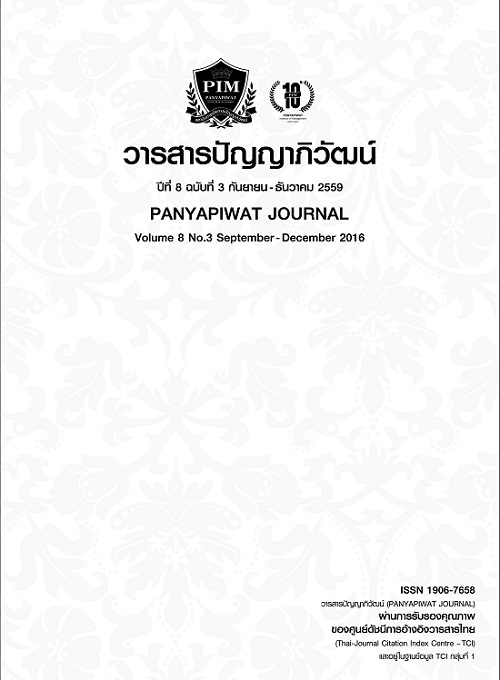การวิเคราะห์องค์ประกอบปณิธานแห่งตนทางการเรียนของนักศึกษาวิชาชีพครู
Main Article Content
บทคัดย่อ
การวิจัยครั้งนี้มีวัตถุประสงค์เพื่อศึกษาองค์ประกอบและระดับปณิธานแห่งตนทางการเรียนของนักศึกษาวิชาชีพครู กลุ่มตัวอย่างที่ใช้ในการวิจัย คือ นักศึกษาวิชาชีพครูมหาวิทยาลัยราชภัฏกลุ่มภาคกลาง ซึ่งได้มาโดยการกำหนดขนาดด้วยวิธีการสุ่มแบบหลายขั้นตอน เครื่องมือที่ใช้ในการวิจัย ได้แก่ แบบวัดปณิธานแห่งตนทางการเรียนของนักศึกษาวิชาชีพครู สถิติที่ใช้ในการวิเคราะห์ข้อมูล ได้แก่ ความถี่ ค่าร้อยละ ค่าเฉลี่ย ค่าเบี่ยงเบนมาตรฐาน และการวิเคราะห์องค์ประกอบเชิงยืนยัน
ผลการวิจัยพบว่า
1. การวิเคราะห์องค์ประกอบเชิงยืนยันของปณิธานแห่งตนทางการเรียนของนักศึกษาวิชาชีพครู พบว่า โมเดลการวิเคราะห์องค์ประกอบของปณิธานแห่งตนทางการเรียน ประกอบด้วย 6 องค์ประกอบ ได้แก่ การเลือกและตัดสินใจทางการเรียน การแก้ปัญหาทางการเรียน การตั้งเป้าหมายทางการเรียน การสนับสนุนตนเองทางการเรียน การควบคุมตนเองทางการเรียน และการตระหนักรู้ในตนเองทางการเรียน มีค่าความสอดคล้องกับข้อมูลเชิงประจักษ์ มีน้ำหนักองค์ประกอบมาตรฐานอยู่ในเกณฑ์สูง อย่างมีนัยสำคัญทางสถิติที่ระดับ .01 และสามารถวัดองค์ประกอบของปณิธานแห่งตนทางการเรียนได้
2. นักศึกษาวิชาชีพครู คณะครุศาสตร์ มหาวิทยาลัยราชภัฏกลุ่มภาคกลาง มีปณิธานแห่งตนทางการเรียนโดยรวมอยู่ในระดับสูง และเมื่อพิจารณาคะแนนเฉลี่ยในรายองค์ประกอบ พบว่า คะแนนเฉลี่ยองค์ประกอบอยู่ในระดับสูงมีจำนวน 4 องค์ประกอบ คือ การตระหนักรู้ในตนเองทางการเรียน (X = 4.141) การตั้งเป้าหมายทางการเรียน (X = 4.068) การแก้ปัญหาทางการเรียน (X = 3.772) การควบคุมตนเองทางการเรียน (X = 3.720) และพบว่าคะแนนเฉลี่ยองค์ประกอบที่อยู่ในระดับปานกลางมีจำนวน 2 องค์ประกอบ คือ การเลือกและตัดสินใจทางการเรียน (X = 3.651) และการสนับสนุนตนเองทางการเรียน (X = 3.473)
The objective of this research was to investigate the components and level of learning self-determination of the students. The research sample was undergraduate students in Education majors of the Central Region Rajabhat Universities. And it is by the Multi-stage cluster random sampling method. The research instrument was a questionnaire of learning self-determined. The research results were analyzed by using a frequency, percentage, average, standard deviation and A Confirmatory Factor Analysis.
The results were found as follows:
1. Confirmatory factor analysis of the learning self-determined of the students revealed that the factor analysis model of learning self-determined consisted of 6 components: learning choice making and learning decision making, learning problem solving, learning goal setting, learning self-advocacy, learning self-control and learning self-awareness. All factors were consistent with the empirical data with a high standard factor loadings and level of statistical significance of 0.1 that could be measured the components of learning self-determination.
2. The students of Faculty of Education, Central Region Rajabhat Universities had high level of the learning self-determination. In considering mean score of each component, the findings suggested that there were 4 components having high mean: learning self-awareness (X = 4.141), learning goal setting (X = 4.068), learning problem solving (X = 3.772), learning self-control (X = 3.720). And found that, there were 2 components with moderate mean: learning choice making and learning decision making (X = 3.651), and learning self-advocacy (X = 3.473).
Article Details
“ข้าพเจ้าและผู้เขียนร่วม (ถ้ามี) ขอรับรองว่า บทความที่เสนอมานี้ยังไม่เคยได้รับการตีพิมพ์และไม่ได้อยู่ระหว่างกระบวนการพิจารณาลงตีพิมพ์ในวารสารหรือแหล่งเผยแพร่อื่นใด ข้าพเจ้าและผู้เขียนร่วมยอมรับหลักเกณฑ์การพิจารณาต้นฉบับ ทั้งยินยอมให้กองบรรณาธิการมีสิทธิ์พิจารณาและตรวจแก้ต้นฉบับได้ตามที่เห็นสมควร พร้อมนี้ขอมอบลิขสิทธิ์บทความที่ได้รับการตีพิมพ์ให้แก่สถาบันการจัดการปัญญาภิวัฒน์หากมีการฟ้องร้องเรื่องการละเมิดลิขสิทธิ์เกี่ยวกับภาพ กราฟ ข้อความส่วนใดส่วนหนึ่งและ/หรือข้อคิดเห็นที่ปรากฏในบทความข้าพเจ้าและผู้เขียนร่วมยินยอมรับผิดชอบแต่เพียงฝ่ายเดียว”
เอกสารอ้างอิง
Deci, E. L. & Ryan, R. M. (2002). Handbook of self-determination research. Rochester, NY: University of Rochester Press.
Higher Education Commission. (2015). Total number of students in 2015 classified by institutions, education level, and gender. Retrieved June 9, 2015, fromhttp://www.mua.go.th/infodata/49/all2549.html [in Thai]
Hongthong, W. (2012). Learning Problem of General Education Courses of Regular Students of Rajabhat Universities. Bangkok: (Unpublished). [in Thai]
Hooper, D., Coughlan, J. & Mullen, M. R. (2008). Structural Equation Modeling: Guidelines for Determining Model Fit. Electronic Journal on Business Research Methods, 6(1), 53-60.
Nirje, B. (2008). The Right to Self-determination. In W. Wolfensberger (Ed.). Normalization: The Principle of Normalization in human services. (pp.176-193). Toronto: National Institute on Mental Retardation.
Ryan, R. M. & Deci, E. L. (2006). Self-Regulation and the Problem of Human Autonomy: Does Psychology Need Choice, Self-Determination, and Will?. Journal of Personality, 74(6), 1557-1586.
Saris, W. E., Satorra, A. & Van der Veld, W. M. (2009). Testing Structural Equation Models or Detection of Misspecifications?. Structural Equation Modeling, 16(4), 561–582.
Shogren, K. A., Palmer, S. B., Wehmeyer, M. L. Williams-Diehm, K. & Little, T. (2012). Effect of intervention with the Self-Determined Learning Model of Instruction on access and goal attainment. Remedial and Special Education, 33(5), 320-330.
Tabachnick, B. G. & Fidell, L. S. (2001). Using Multivariate Analysis. Boston: Allyn and Bacon.Ward, M. I. (2008). The many facets of self-determination. NICHCY Transition Summary. National Center for Children and Youth with Disabilities,5, 2-3.
Wehmeyer, M. L., Abery, B. H., Mithaug, D. E. & Stancliffe, R. J. (2003). Theory in self-determination foundations for educational practice. Illinois: Charles C Thomas Publisher.
Wiratchai, N. (1994). Linear Structural Relationship(LISREL) Statistical Analysis for Social Sciences and Behavioral Science Research. Bangkok: Chulalongkorn University Press. [in Thai]
Zhou, M. & Xu, Y. (2012). A self-determination approach to understanding Chinese university students’ choice of academic majors. Individual Differences Research, 10, 49-59.


